
|   |

|   |
Margam Festival, Bengaluru (March 29 - 31, 2012) - Dr. Sunil Kothari e-mail: sunilkothari1933@gmail.com Pics: Shandilya Srivatsa April 4, 2012 An unusual three day festival focusing on varnams in Bharatanatyam suite was conceived by Usha RK based in Bengaluru. She has been active since past 30 years and is organizing several dance events. As a part of the Golden Jubilee Celebrations of The Music Academy of Bengaluru at Chowdaiah Hall, co-sponsored by Dept. of Kannada and Culture, with support from SLV Enterprises, Indus Sports Resorts Pvt. Ltd, Vaishnavi Palace, Nrityanjali School of Bharatanatyam of Poornima Ashok, Usha succeeded in her aim at focusing attention on varnams. Every evening at 6 pm, dancers took to the stage and within one hour performed a varnam, preceded by a number and included one more number either a javali or a tillana after the varnam. But the aim was to concentrate for nearly 45 minutes on varnam to retain its flavor to relish the structure and scope of abhinaya in a varnam with its musical excellence, bringing back the glory of a varnam in the present day dance scenario, where attention span of the audience has been wavering within 30 minutes and varnams are getting shortened to suit the patience of the audiences. A praiseworthy aim and indeed succeeded as the audience, though thin (on account of forthcoming examinations towards end of March) responded with rounds of applause at the right moments. The evening performances were a connoisseurs' delight. There was a conscious effort on part of the performers to give the best while enjoying the time frame that allowed them to relax and not rush through. Since the presentations of varnams included solo expositions, two duets and one group presentation, the audience got an opportunity to see various possibilities of dancing a varnam in different formats. Soundarya Srivatsa, wife of the vocalist Srivatsa, opened the evening with Pushpanjali and straight went to Tanjore Quartette varnam in Bhairavi, Rupaka tala . The varnam Mohamana is a favourite of dancers. It allows a dancer to display command over nritta, pure dance and abhinaya, expressions. The musical score has also to be done justice to. Soundarya, a former disciple of late Narmada has been studying with Bhanumati and had recently studied under Yamini Krishnamurty when she had conducted a workshop in Bengaluru. Tall with attractive stage presence, Soundarya was in fine fettle. Her nritta was flawless, lines arresting, diagonals delightful, architectonic beauty of Pandanallur bani to the fore, jathis rendered in due measure, and teermanams performed with split second precision, winning rounds of applause from an appreciative audience. She set the mood for the evening from the word go. Nayika watching the Lord in a procession, with dancers performing in front, drummers playing upon drums, the wind instrument players and musicians evoking the splendor - the references to Thyagesha and Bhogesha and the finale with Kama's pancha bana, five flowery arrows - all were enjoyable. There was no attempt to show off which was a welcome approach. The solfa notes and tatta mutti adavus in the end kept audience tapping the feet and keeping the tala. A javali in Kapi and mishra chapu tala gave scope to Soundarya to bring in shades of jealousy, feelings of hurt and showing anger with sarcasm by a nayika, requesting the truant lover to go when he tried to appease her. 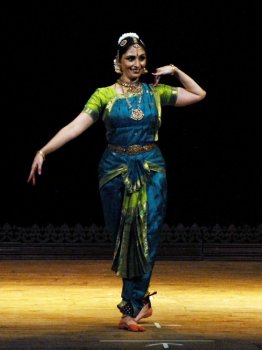 Soundarya Srivatsa 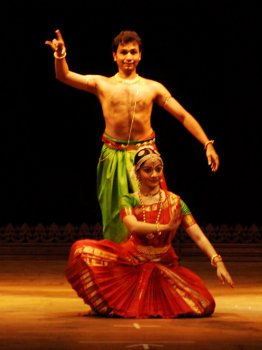 Shijith Nambiar and Parvathy Menon Before the dancing duo Shijith Nambiar and Parvathy Menon from Chennai appeared, there was a brief felicitation ceremony to recognize the services of H N Suresh, Director of Bharatiya Vidya Bhavan. He has been working hard to promote arts in general and dance in particular for the past thirty and more years, and has proved a model for serving with exemplary dedication for an institution like Bharatiya Vidya Bhavan. A well deserved felicitation. He is a part of the cultural scene of Bengaluru and an asset to Bhavan. No wonder after Mathur Krishnamurty-ji's passing away responsibilities have been placed on him for his proven abilities and single minded devotion. Shijith and Parvathy displayed their thorough training at Kalakshetra. I had not seen them earlier. This was also their first performance in Bengaluru. In Neelambari varnam in Sanskrit by Swati Tirunal, the duo displayed imagination, understanding, individual roles, sound nritta, appropriate sancharis, improvisations, with narration and well known episodes about the Lord's helping devotees in distress. Episodes of Gajendramoksha, Draupadi vastrapaharana, Krishna and Gopi playing in full moonlight, and in the finale darshan of Lord Padmanabha through three doors et al were well performed. Except for fast paced teermanams, which did not jell, the nritta was pleasant. The treatment of a varnam was not hackneyed and the two dancers were not emoting the same expressions simultaneously like repeating what one did. Indeed they took up a challenge to perform a varnam by two dancers together and resolved the problem of dancing same thing which would have looked incongruent. They stole the show by performing to a Surdas pada choreographed by Leela Samson, in which Krishna asks Radha who she is and why she has come to play where he is. Radha does not allow Krishna to get away with all flattery, but is won over by his advances and when he picks up the bindi from the floor and places on her forehead, she is overwhelmed. So was the audience, who gave an appreciative applause to this subtle, nuanced gesture. As a pair they danced well and won the hearts of the cognoscenti audience. They concluded with Lalagudi's tillana in Revati raga choreographed by Leela Samson. They had good support from a team of musicians whose finesse was evident highlighting the dance. On the 2nd day, Dr. Suparna Venkatesh, a disciple of Jayalakshmi Alva, presented four young dancers, two male and two female in group choreography in varnam format - her daughter Swetha, Aparna, a disciple of Guru Radha Sridhar, Unnath from Hasan, a disciple of Ambali Rajeshwari, and Srinivasa, disciple of Suparna Venkatesh. In an imaginatively choreographed Pushpasamarpanam, (offering flowers), they created iconic images of Ganesha, Saraswati, offered flowers to Ashta Dikpalas, the deities of eight directions, planted Indra's Jarjaradhwaja, the flag, suggesting the Natyashastra's tradition and set the tone for group work. Suparna chose a varnam in praise of Mahavishnu, in raga Shanmukhapriya, composed by Lalgudi, and wove around his divine deeds, episodes in quick succession, familiar to audiences. Dashavatara, images of Sheshasayi Vishnu, Lakshmi seated near his feet, Brahma on a lotus, arising from his navel (padmanabha),dramatic exposition in episode of Baliraja promising three steps to Lord Vishnu in disguise as Vamana, churning of ocean, Vishnu as Mohini holding the Amritkumbha, pot of nectar, Rama's feet touching Ahalya, Draupadi being rescued from humiliation when Dushashana dragged her into court, pulling her clothes to disrobe her, Gajendramoksha and so on, extolling Mahavishnu's coming to help of the devotee. All these episodes offered the choreographer scope for creating arresting visuals in form of a tableau, often seen in Odissi with number of dancers. Garudasana, Vishnu astride Garuda, Chaturbhuja, four armed Lord Vishnu, juxtaposing two dancers one behind another and extending from behind two arms, familiar image of Vishnu holding Sudarshan chakra, Gada, Shankha and Padma, a dancer seated on floor in Garudasana pose and the four dancers creating sculpturesque images. Alternating expressional text with sparkling nritta, adhering to the format, with four dancers moving in diagonals, straight, frontal, square and circular formations, Suparna succeeded in sustaining interest with felicity and impressive visuals. The scintillating nritta, in quick tempo was well executed by the four dancers. The rigour and demands made on them were obvious and all did justice to the group choreography and the concept. The composition Hari Hari using the text of Shankaracharya and other excerpts, extolling the beauty of Lord Shiva (Hara) and Krishna (Hari), with their adornments, garlands, physical form, exciting the curiosity of the audience to recognize quickly the suggestive forms of either deity, was choreographed well, exploring the text which had similar words, one complete, other one beginning with an alphabet missing, like Kumara and Mara, suggesting son Kartikeya and Kamadeva, the Puranic references were absorbing. I have seen similar text used in Kathak. It arouses curiosity among audience to identify the two deities. The music composed by Srivatsa was the highlight of the dance number and received due appreciation from the audience. 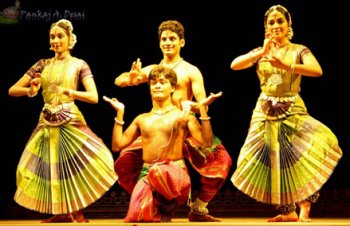 Standing from left: Aparna, Unnath, Swetha. Seated: Srinivas 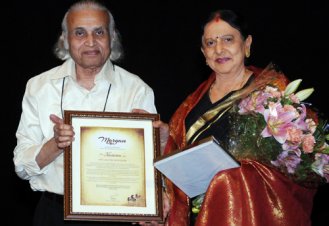 Dr. Sunil Kothari, Guru Lalitha Srinivasan Felicitations followed, honouring Lalitha Srinivasan, who through her institution Nupura, has trained hundreds of students in Bharatanatyam over past three decades and more. Trained by Keshav Murthy, legendary Venkatalakshamma, a palace dancer and a great exponent of abhinaya, Lalitha Srinivasan through her annual Nitya Nritya week long conferences, has hosted morning sessions of discussing various aspects of classical dances and year after year exposing Bengaluru audiences to different dance forms of India through great gurus including Kelucharan Mohapatra, Venkatalakshamma, Vedantam Satyam, performers Yamini Krishnamurty, choreographic works of Chandralekha, Kumudini Lakhia, Birju Maharaj (latest she had invited Ramli Ibrahim from Kuala Lumpur). I have attended those conferences for the last four years. She acknowledges her debt to BVK Sastry who encouraged her to make deep study of Karnataka dance and music traditions. Lalitha Srinivasan is an institution and a name to reckon with in the world of Bharatanatyam in Bengaluru. The evening belonged to the super star Bharatanatyam exponent Satyanarayana Raju, a disciple of Narmada, who in turn had been a disciple of Kitappa Pillai. She had trained so many young dancers of Bengaluru, establishing very high standards. Satyanarayana, affectionately known as Sathya, has been her prize disciple and he has maintained Narmada's style in an admirable manner. For a change, Sathya began with jatiswaram in raga Abhogi; Jatiswaram like alarippu is also of late rarely performed. He went through the paces with ease of a seasoned dancer, executing nritta with clear lines to the soulful vocal rendering by Srivatsa. It was a pleasure to watch jatiswaram after a long interval. Sathya set the mood and went on to perform his favourite Ashtaragamalika Varnam, set to rupaka tala, having studied it from Narmada. March 30th happens to be the death anniversary of Narmada teacher, dedicating it to her memory. With an arresting stage presence and a handsome figure for a male dancer, Sathya's Bharatanatyam has a quiet dignity. His nritta is bereft of bravado, but is sound and replete with beauty of geometry, his lines are neat, long arms reveal the grandeur of the form, steps are light, utplavanas flawless, and landings are smooth. The overall presentation is aesthetic and full of dignity. His visage wears bhavas which suggest humility, becoming a devotee, the pleadings to the Lord are subtle, sober and eyes register them enlivening the mukhajabhinaya for display of nritya in exposition of a varnam. The varnam dwelt on judicious combination of bhakti and shringara which came through in Sathya's presentation. Describing the form of Lord Shiva, clad in Vyaghracharma, tiger skin, arms and neck adorned with serpents, Lord in his Ardhanarishwara form, who resides in Tanjapuri, to that Brihadishwara the devotee offers pranam. He embellished the concluding part with split second teermanams, utplavanas and soft landings. The glory of a Varnam with its multi-layered elements of musical notes, recall the bhava in tatta mutti and movements which have a rounded completeness, setting Sathya apart from other performers. The rasa sthanas, the episodes which linger long in memory, like begging the Lord to have a glimpse of his form and the slight moving of Nandi, the devotee being overwhelmed at the darshan of the Lord, eyes filled with tears and lying on floor in sashtanga dandavata pranam, left an indelible impression. What was most interesting was Sathya took nearly forty minutes to unfold the formal beauty of the varnam. No wonder, he received a thunderous ovation. In abhinaya he excelled in Ramadasa composition. Impersonating Shabari waiting for Lord Rama's arrival, advanced in age, barely able to stand erect and physically almost disabled - it was an amazing transformation in terms of angikabhinaya that Sathya achieved. No wonder the audience applauded at his moving portrayal. Testing the fruits to check if they were not sour, with suggestion, he further displayed his command over abhinaya. The feeling of total surrender was the highlight of the recital. The musical support from Shakuntala Raghavendra for nattuvangam, Srivatsa's vocal, Lingaraju's brilliant mridangam and flute by Narsimhamurty enhanced the musical appeal of the performance. The concluding tillana had all traditional elements which makes it a complete delight to watch it as a final number. Kathak exponent Murali Mohan Kalva's introductions were apt and his references to Balasarswati's comparing a Bharatanatyam recital as entering a temple and the place of varnam as entering a sanctum sanctorum were apt and memorable. He concluded with a tillana in Ratipatipriya raga by TV Gopalakrishnan with flourish. 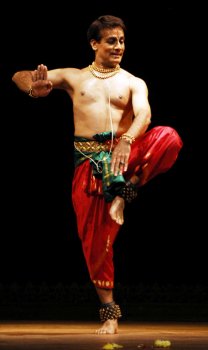 Sathyanarayana Raju 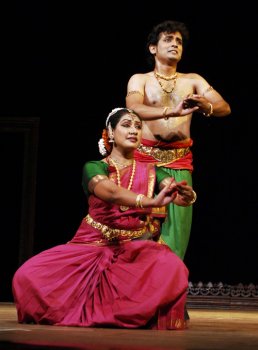 Somashekhar and Sowmya On the final day, young couple Somashekhar and his wife Sowmya's recital was impressive. Disciple of Dr. Suparna Venkatesh, Somashekhar has imbibed the training of Bharatanatyam in a commendable manner. He has a youthful and pleasant stage presence. Disciple of Nirupama, Sowmya has a very sensitive visage, registering expressions in a manner which the rasikas relish. Sowmya's dancing is complimentary to that of Somashekhar and their combined presentation of a varnam was another enjoyable performance. Selecting Dandayuthapani Pillai's varnam in Nattakuranji raga and adi tala, it covered a gamut of emotions and episodes. In quick succession and in a suggestive manner, they touched upon Nandanar's request to the Lord to give a glimpse of his divine beauty. Somashekhar performed the role with appropriate bhavas; when the Lord danced, Nandi, Narada, Vishnu, Brahma, Saraswati, all played various instruments, the episode of Halahala poison, Lord Shiva drinking it and being referred to as Nilakantha, begging the Lord for his blessings, surrendering to the Lord, and showing other details, both acquitted themselves well. The youthfulness and sparkle in their nritta and abhinaya were enjoyable. Somashekhar's vigorous and Sowmya's graceful dancing was well juxtaposed. The abhinaya to a sequence from Arunachala Kavirayar's Ramanatakam by Sowmya in solo presentation , wherein Sita reminds Lord Rama leaving her behind and going to forest, about his promises to her when she got married to him, that he shall never leave her alone et al were enacted with praiseworthy sensitivity and deep feeling. Though they had to conclude their performance for time constraint, they indeed performed with finesse and involvement. Guru Radha Sridhar was felicitated after their recital. Trained under US Krishna Rao, Chandrabhaga Devi, Muthiah Pillai and Venkatalakshamma, Radha Sridhar has another exceptional qualification as an ace mridangam player. Female artistes playing mridangam are indeed rare. Radha Sridhar's achievements are many. Her disciples are a legion. She has received several honours including the latest Karnataka Rajya Kalasri award. Renowned dance critic of The Hindu, Leela Venkataraman was asked to felicitate her. She recalled her early association and their studying Kathak from Keshava Murthy when they were young. Later on she came to know that Radha Sridhar had studied Bharatanatyam from Keshava Murthy. It is a known fact that Keshava Murthy had left Kathak and taken to Bharatanatyam. Leela Venkataraman referred to Radha Sridhar's expertise in mridangam which sets her apart, a vastly gifted dancer and a guru. Speaking after felicitations, Radha Sridhar laid stress on solo presentation of a varnam which she finds very satisfying and more challenging. 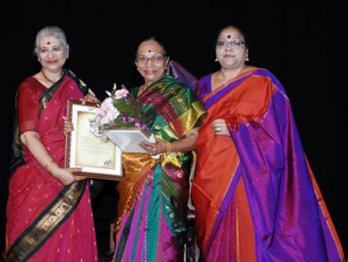 Leela Venkataraman, Radha Sridhar, Usha RK 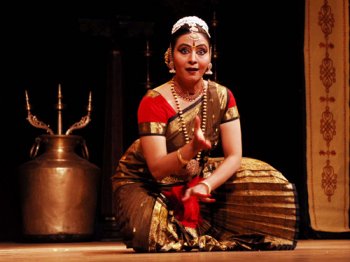 Poornima Ashok The finale was by Poornima Ashok, a disciple of Radha Sridhar and Dhananjayans. She began with an unusual alarippu, to the jathis set by Kiran Subramanyam in pancha jatis and pancha gatis. A welcome innovation. It is true that of late alarippu is rarely performed, though it is one of the most interesting and fascinating numbers. Poornima followed it with a Tulsidas Bhajan, "Thumaki chalat Ramachandra." She depicted vatsalya bhava and went on to a varnam of Dandayuthapani Pillai for which Kiran Subramanyam had set the jathis. This innovation also was well received and Poornima executed the jathis competently with suggestive abhinaya. As exponent and guru VP Dhananyajan had observed during the morning seminar, she too called her item as Nrityopahara. Set to Navaragamalika, the well known varnam "Swami aria kodiva" dwelt on the theme of separation of a nayika, her pleadings to the Lord to be together when spring was in full bloom, when the lovers should be united. Poornima developed abhinaya with the progression of the varnam alternating between the nritta and expression. Expressions for sringara were dignified and appropriate, full of auchitya. Describing the form of the Lord incomparable, more handsome than 'koti manmatha,' her face wore an effulgent look. The varnam as a form, with Kiran Subramanyam's jathis developed in an interesting manner. Devarnama of Purandaradasa, saw devotee, gopi, requesting Krishna to leave her alone and not to play flute so charmingly - what in terms of Natyashastra terminology was bhava called 'bibboka'- when nayika pretends that she does not want lover to upset her. But she enjoys his gestures and advances. She finally snatches the flute away from Krishna and in a playful mood exits. The vocal rendering by Nanda Kumar was melodious and added an additional dimension to the dance. Flute by Swami, nattuvangam by Venkatakrishna and mridangam by Srihari provided excellent support.
In the morning seminar, senior dancer and guru Dhananjayan spoke about how after leaving Kalakshetra, he and Shanta explored the repertoire which they call Nrityopahara, and choreographed new varnams etc. And they succeeded in maintaining the traditional core. Leela Venkataraman spoke about the structure of varnam and how it can lead to higher realm of experience. Quoting a recent performance by Swapnasundari in Nritya Bharati festival in Delhi, she mentioned how a gifted artiste can engage an audience for nearly an hour by excellent presentation of a varnam. Lalitha Srinivasan also laid emphasis on a solo rendering of a varnam and how she too has explored novel themes for a varnam using the theme of various rivers. I spoke about memorable sancharis I had seen in varnams and what are the rasa sthanas, the stages of relish, scope for abhinaya in varnam by Kamala, memorable varnams by Yamini Krishnamurty, rare Taana Varnam by Shanta Rao. Also why choreographers present varnams in say a duet form, in a group form by more dancers, the compulsion of the changing times and also to give opportunities to more dancers. How the tastes have changed and audiences' patience span is less nowadays. Kiran Subramanyam demonstrated how nritta movements are used by him for interpreting abhinaya, for the flow of varnam and instead of a dancer waiting how she can continue performing, retaining the structure of a varnam. He is also an expert mridangam player and has shown how varnam can be embellished enhancing its appeal. Charles Ma, a disciple of Poornima Ashok demonstrated a part of varnam followed by Anuradha Vikranth, a disciple of Nirupama, during the morning session. Usha summed up the purpose of the seminar eloquently. The Margam Festival offered the interested audience in classical Bharatanatyam dance form and its traditional suite, excellent opportunity to witness varnams in unhurried manner. The festival drew attention to the need for 'revisiting' gems of compositions with enough time for exposition of a varnam. It was indeed a Herculean task but the team work was wonderful. The Chowdaiah Hall, the key persons of The Music Academy , Bengaluru making this event a part of the Golden Jubilee celebrations, light designing by Sai Venkatesh, very impressive and highly aesthetic stage design by Sathya, compering by Usha and the performances by dancers, were of a very high order. Similar three day festivals in future will indeed draw crowds and bring discerning audiences back to classical dance forms. Both Leela Venkataraman and I, who were invited from Delhi to attend the festival and participate in the seminar, thoroughly enjoyed all the sessions which began dot on time. Usha RK and all who lent her support including dancers and musicians deserve congratulations for such an enriching event.  Dr. Sunil Kothari is a dance historian, scholar, author and a renowned dance critic. He is Vice President of World Dance Alliance Asia Pacific India chapter, based in New Delhi. He is honored by the President of India with Padma Shri, Sangeet Natak Akademi award and Senior Critic Award from Dance Critics Association, NYC. He is a regular contributor to www.narthaki.com, the roving critic for monthly magazine Sruti and is a contributing editor of Nartanam for the past 11 years. Post your comments Pl provide your name and email id along with your comment. All appropriate comments posted with name and email id in the blog will also be featured in the site. |